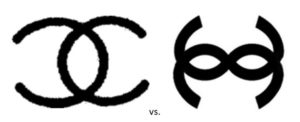On 18 July 2017, the General Court held that the two designs shown here produced the same overall impression (case T-57/16; not yet available in English). The EUIPO – both first and second instance – had held otherwise. The Cancellation Division described the designs as superimposed C’s (Chanel’s logo) and 3’s (the design under attack), respectively. This was endorsed by the Board of Appeal, which further emphasized the differences in the central parts of the designs, namely, a “very recognisable infinity symbol” in the design under attack vs. a vertical oval central space with pointed ends in the Chanel logo. Even taking into account the significant freedom of the designer when it comes to ornamentation, these differences produced a different overall impression (decision of 18 November 2015 in Case R 2346/2014-3).
The General Court knew better. It gave some importance to the similarities between the designs and the fact that the design under attack “could be perceived, to a certain extent, as inspired by the idea of the Chanel logo” (para. 55). Therefore, even though the designs at issue “presented certain differences in their central parts”, the external parts, namely the silhouette, and, as a result, the overall impression, were “very similar and practically identical”. Moreover, the differences in the central parts would “dissolve in the overall impression” and the sole difference was that the design under attack had two pointed ellipses while the Chanel logo had one.
The Court was likely influenced to an extent by the evidence produced by Chanel relating to the use of the attacked design on sunglasses, and (at least also) the designs at issue as they appeared on these real-life products.
One cannot help but wonder if, from a design law perspective, this was the right conclusion. This author i s all for protecting famous marks from abuse and encroaching. In fact, the very design at issue was already declared invalid on 26 April 2017 by the Third Board of Appeal as being an infringement of Chanel’s trademark rights (Case R 1732/2015-3). Taking into account the fame of the Chanel logo and the corresponding scope of protection, the Board agreed that French law entitled Chanel to prohibit the use of its distinctive sign in the design under attack (Article 25(1)(e) Community Design Regulation). However, the scope of protection of designs is different from that of trademarks. The comparison is entirely neutral and considerations of fame have no room. If what the Court held in this case is right then a very large number of designs currently registered in the EU are doomed.
_____________________________
To make sure you do not miss out on regular updates from the Kluwer Trademark Blog, please subscribe here.



